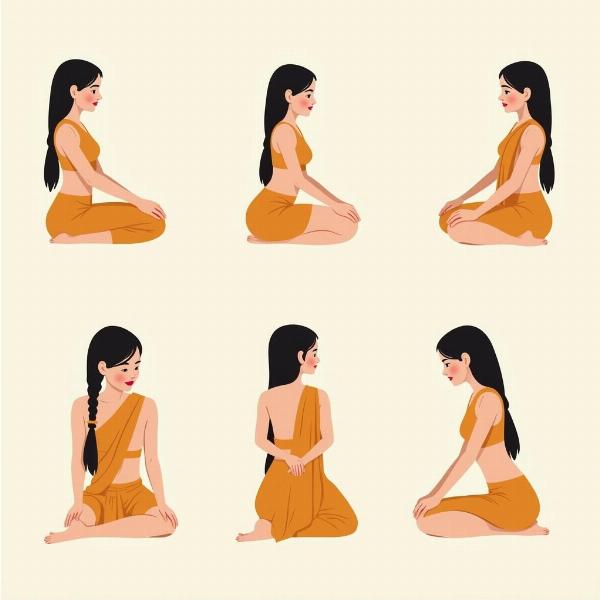Understanding gesture and posture meaning in Hindi adds a crucial layer to communication. Beyond spoken words, these non-verbal cues offer rich insights into emotions, intentions, and social dynamics. Whether you’re learning Hindi or seeking to deepen your cultural understanding, grasping the nuances of body language is essential.
Decoding Non-Verbal Communication: Gesture and Posture Meaning in Hindi
Indian culture, rich in tradition and etiquette, places significant emphasis on non-verbal communication. Gestures and postures, deeply embedded in the social fabric, often convey more than words alone. Let’s explore the fascinating world of gesture and posture meaning in Hindi, uncovering the subtle messages conveyed through body language. From respectful greetings to expressions of disagreement, understanding these cues can significantly enhance your interactions in Hindi-speaking environments.
Common Indian Gestures and Their Meanings
Several gestures are commonplace in India, carrying specific meanings. The Namaste, with palms pressed together and a slight bow, is a universal greeting conveying respect. Pointing with the index finger is generally considered rude, while using the whole hand is more acceptable. A head wobble, neither a nod nor a shake, can signify acknowledgement, agreement, or even polite refusal depending on the context.
Postures that Speak Volumes
Postures also play a crucial role in communicating respect and social standing. Sitting cross-legged on the floor is a traditional posture, often seen as respectful, especially in religious or formal settings. Standing with hands clasped behind the back can indicate attentiveness or respect, particularly when interacting with elders. Avoid pointing your feet directly at someone, as this is considered disrespectful.
 Indian Postures Respect Meaning Hindi
Indian Postures Respect Meaning Hindi
Context is Key: Interpreting Gestures and Postures
While these are general guidelines, the gesture and posture meaning in Hindi is highly context-dependent. A gesture that is perfectly acceptable in one situation might be inappropriate in another. Pay attention to the overall communication, including facial expressions and tone of voice, to accurately interpret the message. Observing how others communicate non-verbally is also a valuable learning tool.
Navigating Social Interactions with Body Language
Understanding the gesture and posture meaning in Hindi can significantly improve your social interactions. By using appropriate body language, you can demonstrate respect, build rapport, and avoid misunderstandings. This is particularly important when interacting with elders or in formal settings.
Understanding “Gesture and Posture Meaning in Hindi”: A Deeper Dive
Dr. Anjali Sharma, a renowned anthropologist specializing in Indian culture, emphasizes the importance of non-verbal communication: “Gestures and postures are integral to Indian communication, adding layers of meaning that transcend spoken words. Understanding these nuances is crucial for effective cross-cultural interaction.” This highlights the intricate relationship between culture and communication in India.
Professor Vikram Singh, a linguistics expert, adds, “Body language can often be more revealing than verbal communication. By paying close attention to gestures and postures, you can gain deeper insights into the speaker’s true intentions and emotions.”
Conclusion
Decoding gesture and posture meaning in Hindi unlocks a deeper understanding of Indian culture and communication. By mastering these non-verbal cues, you can navigate social interactions with grace, build stronger relationships, and demonstrate respect for the rich traditions of India.
FAQ
- What does the Namaste gesture mean? The Namaste is a respectful greeting, signifying respect and acknowledging the divine in others.
- Is it okay to point with my index finger in India? Pointing with the index finger is generally considered rude. It’s better to use the whole hand.
- What does a head wobble mean in India? A head wobble can have various meanings, including acknowledgement, agreement, or even a polite refusal, depending on the context.
- Why is understanding body language important in India? Body language often conveys more than words alone, adding crucial layers of meaning to communication.
- How can I learn more about Indian gestures and postures? Observing others, asking questions, and immersing yourself in the culture are great ways to learn.
- What is the significance of sitting cross-legged in India? Sitting cross-legged is often seen as a sign of respect, especially in formal or religious settings.
- What should I avoid doing with my feet in India? Avoid pointing your feet directly at someone, as this is considered disrespectful.
You Might Also Be Interested In
tate meaning in hindi
body movement meaning in hindi
attahiyat meaning in hindi
khechar meaning in hindi
Meaning-Hindi.in is your trusted partner for all your Hindi translation needs. We offer a comprehensive range of services, from business and legal document translation to website localization and technical manual translation. Our expert team ensures accurate, culturally sensitive translations that bridge language barriers and facilitate effective communication. Contact us today at [email protected] or call us at +91 11-4502-7584. Meaning-Hindi.in – Your gateway to understanding Hindi.